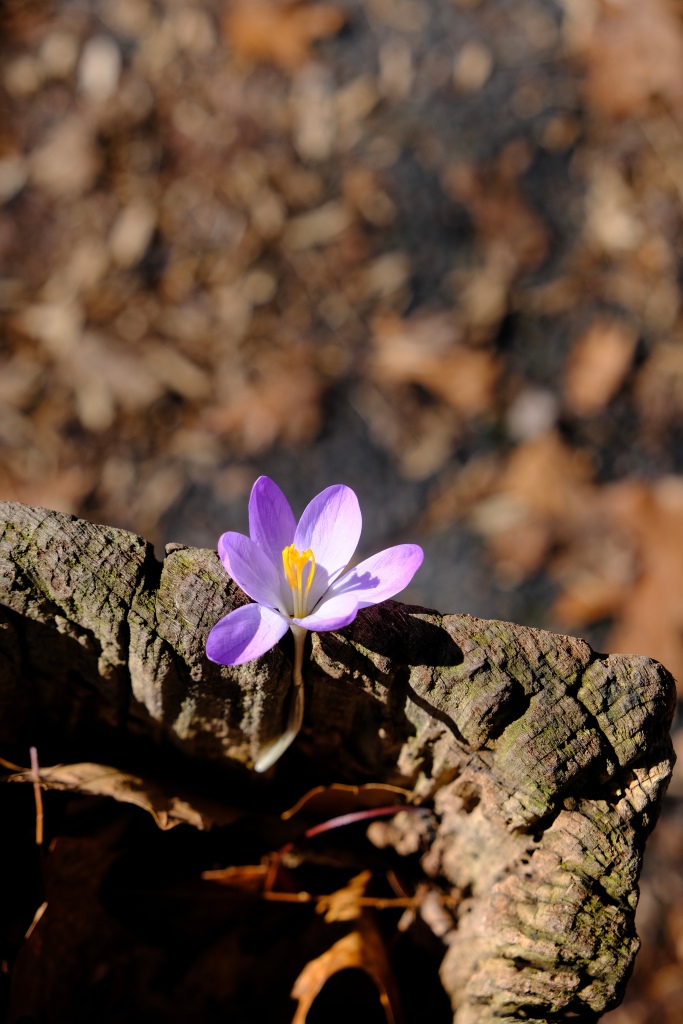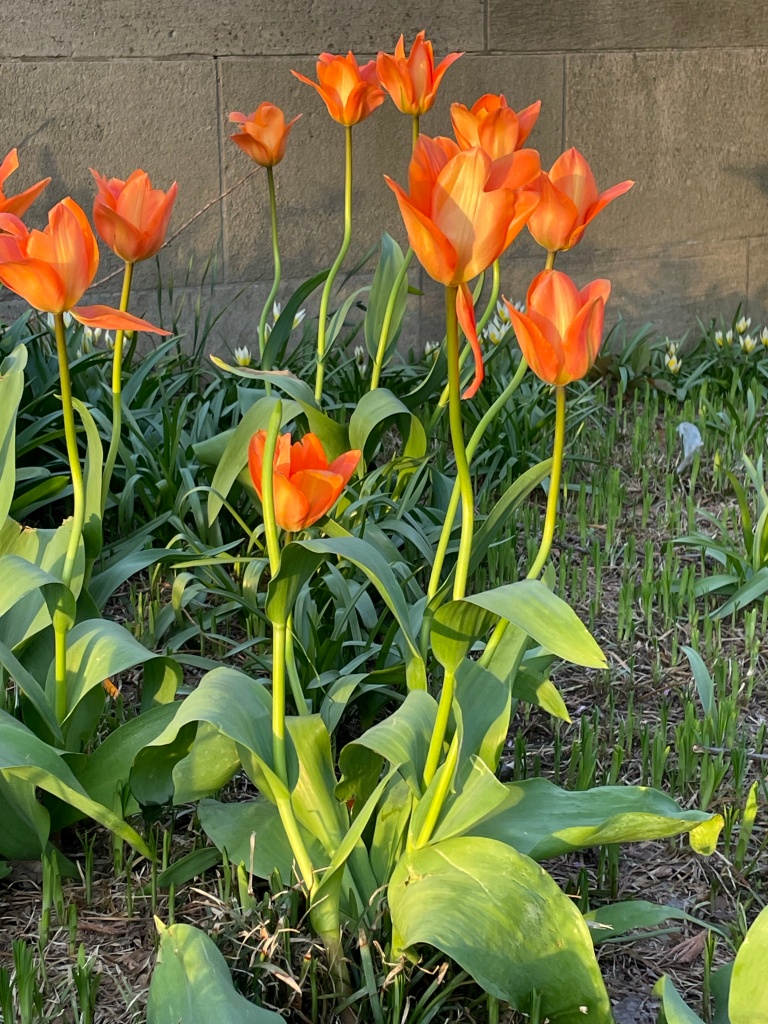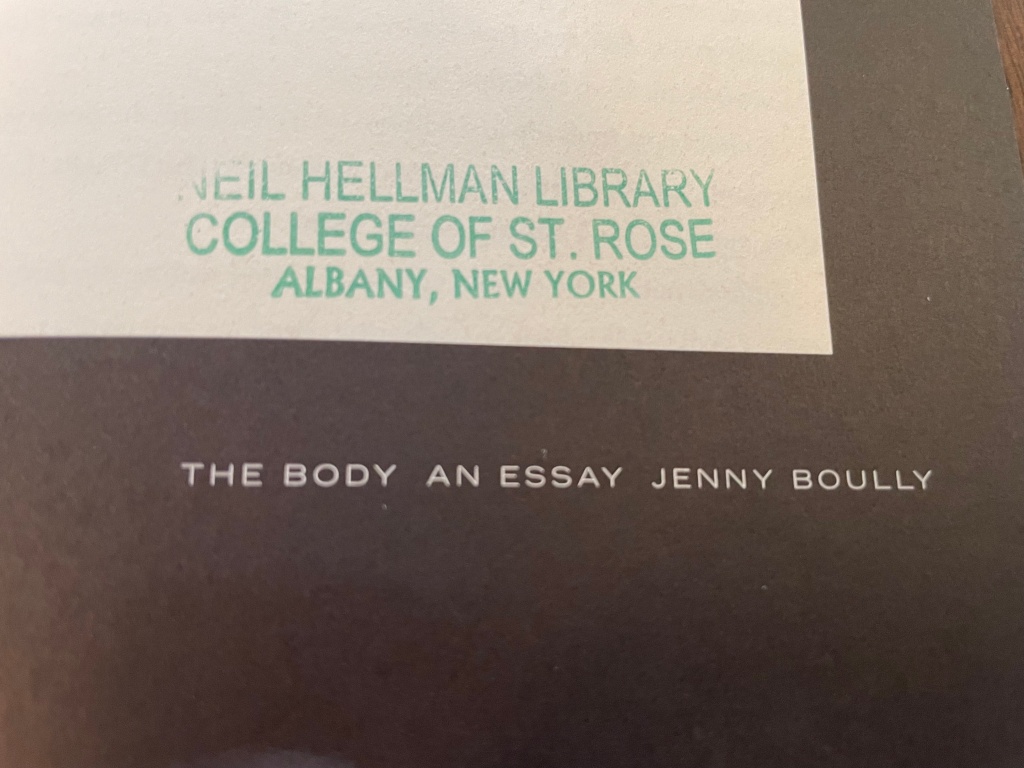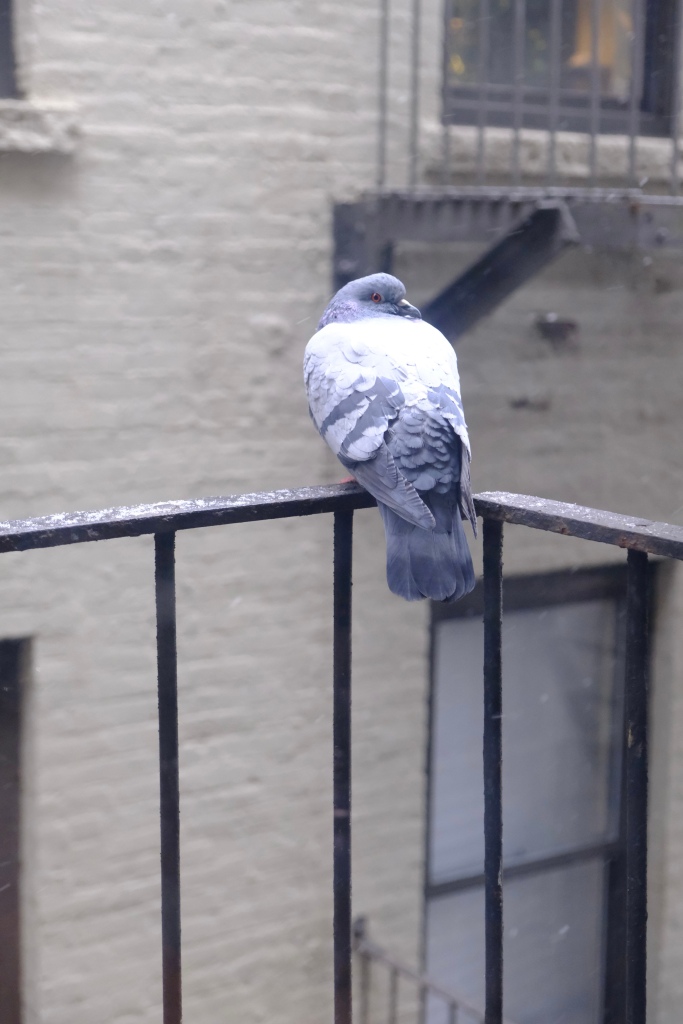April 21, 2024
Blogging “A Lost Lady”
I have once again picked up a Willa Cather novel off of a free community bookshelf and inadvertently fallen into liveblogging my way through it.
If anyone’s interested in following along, all posts are tagged “a lost lady” over at my Tumblr! Once again, not promising any particularly organized analysis, just thoughts as they occur!
April 16, 2024
I hate this city but I love it
I was away this weekend to attend a memorial service in my hometown. I landed early enough on Sunday to go for an evening walk. It’s the time of year when golden hour turns truly gold, and it reminded me just a little bit what I’m doing here in the first place.
March 28, 2024
I really love seeing all the places where my Interlibrary Loan books have traveled here from.
(I wish I’d liked this book more; I liked the idea of it so much. It did remind me a lot in some ways of the Taiga Syndrome, so if you liked that one, you might give this a shot!)
March 12, 2024
Here’s something I’ve gotten curious about:
I spent the whole first season of Outer Range desperately trying to get other people who had a sci-fi fandom background to talk to me about the show, because there are just so many familiar tropes and layers and references being played with in it, and…I couldn’t find very many, and I think that has a lot to do with how Amazon marketed the show.
Which was not as a cosmic horror/sci-fi. So I think it may be that not very many people who were fans of other more similar shows like Fringe or Dark started watching it.
And while that was frustrating to me personally, I actually think it’s kind of beautiful what they did accomplish, which was apparently to bring in a lot of viewership who didn’t seem to have almost any familiarity with other television sci-fi.
If that’s you–if you watched Outer Range and loved it, not knowing going in what it was, or not having watched or read much or any other sci-fi, I would actually love to hear about your experience of the show.
What did you think it was? What surprised you? What kept you watching? What do you think is going on?
March 10, 2024
Signpost

Still loving the new camera. Here’s one from my first spring hike last weekend.
February 20, 2024
The appropriation of “intentional community”
I’m continuing to adapt some of my Twitter threads into posts for easier archiving, access and sharing. This is adapted from a thread I wrote in 2022.
There’s a variety of housing development we’ve grown accustomed, I think, to reading articles about in the news world of autism and developmental disability. Particularly as the largest groups yet of autistic young people identified in childhood reach young adulthood and leave school in need of transition support services and housing resources. Often conceived of by groups of parents and families of autistic young adults, privately funded, frequently described as new or innovative models for providing housing and support resources in a streamlined, less onerous manner, these developments are often situated outside of metropolitan areas/in quasi-rural settings, and may or may not be located in such a way as to allow residents independent access to local communities and shopping, work, social or educational opportunities.
Autistic self-advocates, activists, and organizations often decry these arrangements as neo-institutions, based on the way they effectively segregate disabled residents from their broader communities and make service provision dependent on use of that segregated housing and vice versa. That they reconstitute, with a sanitized façade, all the risk factors for abuse of older institutions. Proponents arguing that they are not institutions and in fact should be considered eligible to receive HCBS funding—funding usually dedicated to ensuring that disabled people can receive the services necessary for them to live at home, in their own communities—and often refer to them as “intentional communities.”

Critics and self-advocates say that “intentional community” is a naked attempt to rebrand institutions as something other than what they are, that “intentional community” is a euphemism for “institution.”
I tend to fall on the side of critics of these kinds of developments, which while I believe are undoubtedly well-intentioned, also have a high potential to foster abuse, unnecessarily isolate residents, and fail to enable true autonomy.
But something I think we’ve failed to emphasize is that “intentional community” here is not simply a misleading euphemism for neo-institutions, therapeutic farms, or segregated housing developments for autistic and developmentally disabled people.
Though it is misleading, on several levels, “intentional community” is also the term for a whole entire other movement, and a variety of housing and living situations that have nothing whatsoever to do with these places, and whose terminology is being appropriated for their misrepresentation.
And I know that the people spearheading support for these developments know that “intentional community” is not an accurate term for what they’re selling, but I’m not sure how many of the critics of these places realize that.
That “intentional community” is not just a term they made up. It is a term they are co-opting from a whole other movement and loose association of communities.
Here is the website for the Foundation for Intentional Community.
Here is a profile of one of the communities registered with FIC.
How much resemblance does this bear to the kind of housing development being pushed as “intentional community” by the people like the author of this tweet?
FIC defines an intentional community as “a group of people who have chosen to live together or share resources on the basis of common values.”
Wikipedia describes an intentional community as “a voluntary residential community,” being designed to have “a high degree of social cohesion and cooperation,” of people who often share ideals, political, social, or spiritual philosophy, and who typically share “responsibilities and property.”
An intentional community, by definition, is a group of people who’ve come together of their own volition to form and maintain a certain kind of community in line with their own values. The people who live in an intentional community are, by definition, actively involved in its control, maintenance, and governance.
“Not all intentional communities are Willowbrooks” is a technically true statement because, fundamentally, zero true intentional communities are Willowbrooks. Because Willowbrook was, by any good faith definition whatsoever, not an intentional community.
It was an institution.
Now, it is also true that not all institutions are Willowbrooks. There are many ways in which the disability rights and neurodiversity movements argue that all institutions are bad, but it’s true that they’re not all Willowbrooks. Willowbrook was a particularly bad institution.
(Though I’d be remiss not to note that institution survivors I’ve known have often said that the most insidiously dehumanizing institutions they’ve encountered have not necessarily been the ones that most resembled Willowbrook, but the ones where the grounds and buildings were beautiful, the rooms were clean and bright, and the staff were superficially kind. That what makes an institution are the power dynamics and not the architecture or whether there’s a pool, or the number of other people who live there, or even whether the physical abuse and neglect are particularly overt.)
But the reason “not all intentional communities are Willowbrooks” is because Willowbrook was not an intentional community.
And what that also does not mean is that all intentional communities, in the authentic sense of the term, are good places. I’m not a member of one, I’ve never lived in one (though I’ve known people who have), but just from my experience of human communities in general, I’d be willing to bet that they range from very good arrangements for some people, to very dysfunctional.
But their defining characteristic is that they are voluntary associations of people who are choosing to live together in a certain way, with a high degree of cooperation and coordination. They are not places where you send someone to live in a certain way because they are disabled or as a shortcut to meeting their support needs in a way that would allow them to live in a more integrated way with their wider community.
That would be an institution. (Or a congregate care facility. Or a group home.)
“But what,” goes a frequent question, “if someone wants to live with all other disabled people?”
That’s cool! I think they should be allowed to. There might even be an intentional community for that.
But if someone is being placed or sent to live in a place with all other disabled people such that they don’t have control over their access to the broader community or how they live or where they don’t share in cooperative control of that community, they are not in an intentional community.
That’s a term that refers to a distinct set of movements and philosophy of living with its own entire history, which is being misappropriated by advocates of a housing model that more closely fits the description and history of an institution… or that could, I think, resemble something more like a supportive housing arrangement, if the people formulating these places had more awareness of how not to recreate an institution.
And I don’t want to drag them into it unwillingly, but I would be very curious what participants in the actual intentional community world would think of the attempt to brand neo-institutions or segregated housing developments as part of what their movement stands for.
February 19, 2024
Reading
I’m facing up to the possibility of having to write a book that I don’t really want to have to write (mostly because I just wish it already existed), but Robert A. Caro is giving me comfort and insight.
I’ve never even read one of his biographies (yet), but I saw an exhibition on his writing process last year at the New-York Historical Society Museum, the way he drafted everything by hand like I do, and thought “huh, maybe there is actually a way for me to do this.”
February 18, 2024
The flood
God said to Noah and to his sons with him, “As for me, I am establishing my covenant with you and your descendants after you, and with every living creature that is with you, the birds, the domestic animals, and every animal of the earth with you, as many as came out of the ark. I establish my covenant with you, that never again shall all flesh be cut off by the waters of a flood, and never again shall there be a flood to destroy the earth.” God said, “This is the sign of the covenant that I make between me and you and every living creature that is with you, for all future generations: I have set my bow in the clouds, and it shall be a sign of the covenant between me and the earth. When I bring clouds over the earth and the bow is seen in the clouds, I will remember my covenant that is between me and you and every living creature of all flesh; and the waters shall never again become a flood to destroy all flesh. When the bow is in the clouds, I will see it and remember the everlasting covenant between God and every living creature of all flesh that is on the earth.” -Genesis 9:8-17
I visited a new church this morning, and this was the reading from the Old Testament. And it wasn’t the direction the pastor went with it in the sermon, but I couldn’t help wondering whether or how anyone has preached on these verses with reference to climate change recently and its increasingly apparent dire consequences.
What does it mean that we have a covenant with God in which He says He will never again destroy the earth and all life in a flood, but the ice caps are melting? We are suffering from and will continue to suffer from catastrophic, life-altering flooding from extreme weather and rising sea levels.
Is the covenant technically not broken as long as all life doesn’t perish (which is unlikely, even in the very worst case scenario)?
Is it possible for humanity to have broken covenant with God not to destroy the earth with flooding, even if He didn’t break it with us?
Has anyone experienced a church or a pastor addressing climate change in either words or actions in what feels like a particularly effective way?
February 13, 2024
Hey
More play with my new camera! Here’s one of my favorite recent shots, from the last snow day in New York before this one.
January 27, 2024
“Loss of self,” and lacking the experiences of other women
I’ve been looking around lately for decent books about the experience of giftedness or twice exceptionality in adulthood (though mostly coming up short), and one that I came across was Reclaiming the Lives of Gifted Girls and Women by Joan Franklin Smutny.
The book draws so heavily on the 1992 AAUW report “How Schools Shortchange Girls” and also on the work of Carol Gilligan that I was surprised in a way the author didn’t cite Mary Pipher as well, and though she doesn’t, I found myself almost immediately not identifying with what it describes—the focus on the loss of self of middle school-aged and adolescent girls. That they crumple under the sexist expectations of parents, teachers, and broader society, and lose their self-concept, lose their beliefs in their own abilities, give up on their own ambitions, slowly give their lives away to the approval and expectations of others.
That thesis wasn’t the only thing, but it was one of the big things that made reading Reviving Ophelia feel like reading about an alien species when I was a teenager.
It’s not that I didn’t feel the dissatisfaction of adults and society, but I felt like I never let go of my authentic “self” in that way for the love or approval of others, in part because I knew I couldn’t do what they wanted, anyway.
I could not be the girl they wanted. I couldn’t even pretend.
I could see, on and off in various ways since I was extremely young, that a whole lot of the various paths that other people saw for me just weren’t going to work.
Invisible disability gave me something that I knew. That I knew and they didn’t, that meant I knew more about my life and myself than they did. And I knew it, even though I didn’t have those words for it.
Looking back, it was protective in a way, though it did not feel like it at the time, that a certain level of caretaking responsibility or prioritizing the feelings or needs of others was something I couldn’t take on or sacrifice myself for because I was not capable of it.
And there’s a huge, huge parallel with how many autistic women now tell a story of not knowing who they really are, or of not having a core self, because of intensive masking from an early age, or because they learned to adopt the personality or mannerisms or the likes and dislikes of peers or whoever would take them under their wing, and I just could never do that. And I’m cut off from a lot of the dominant narrative about autistic women because of it.
And I’m very wary of portraying this experience as more virtuous or more honest or playing “more disabled than thou” about it, but it is exasperating, when this is so often understood as why things are the way they are for autistic girls and women, and it just has nothing to do with me.
It’s interesting to me that while, in many ways, I think disabled and twice-exceptional people are probably having experiences that the existing literature about giftedness doesn’t account for very well at all, but this is something I see in writing about both giftedness and autism/disability… but don’t relate to at all from either direction.
I want to know more about the way things have been for the other autistic and gifted people who couldn’t pretend or couldn’t mask in the ways that term has come to signify.
In a way, I wonder if we have better lives, if we’re more self-knowing, more secure in our abilities, more adept at self-accommodation, more likely to have found a niche professionally, because when it’s very clear what you’re not capable of, it’s easier in a way to decide to expend your resources on what you are.
I also wonder if we’re more likely to be lonely, less likely to have a certain kind of support network or friend group, because we both can’t and won’t sink energy into superficial relationships or pretending to be something we’re not just to have them, because we have to be so extremely wary of wearing ourselves thin, because we can’t adopt or maintain the persona that so many other women seem to look for in friends…and because we may not be capable of performing the kinds of caretaking (emotional or physical) that solidify family and other kinds of close relationships.
I desperately want to see someone else talk about what the costs of that are.




